Durga Puja organizers at Girish Bhawan adopt new-age immersion technique
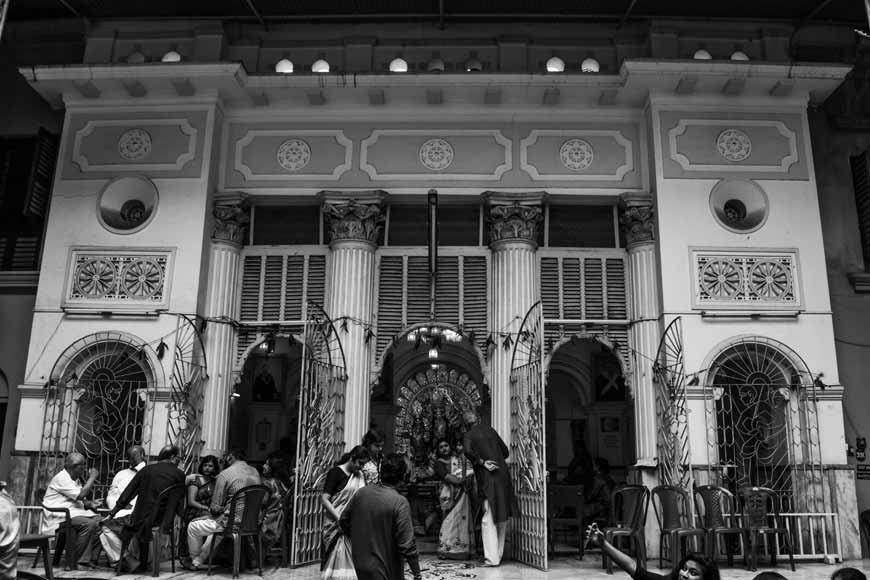
The month of October carries an aura of piety and celebration, cutting across all socio-economical and religious barriers. This is the auspicious month for Durga Puja, the autumnal festival (Sharodiya utsab), celebrated in different parts of the country, but most notably in the eastern region, especially Kolkata. This year its double whammy for the city as 'Durga Puja in Kolkata' was inscribed in UNESCO's Representative List of the Intangible Cultural Heritage of Humanity.'
But this is also the time when the pollution of the river water increases alarmingly and repeated appeals by conservationists fall on deaf ears. The Ganga is already highly polluted due to indiscriminate discharge of human and industrial waste into it for years. Idol immersion during festive occasions like Durga Puja has been putting significant stress on the river. Chemical dyes and colours used in the idols contain poisonous elements like mercury, zinc oxide, chromium and lead, all potential causes of developing serious health hazards, including allergies and cancer. The toxic elements and metals dumped in the Ganga, also deplete the level of dissolved oxygen in its water, particularly near the river bed, triggering a condition known as hypoxia, in which marine life cannot survive
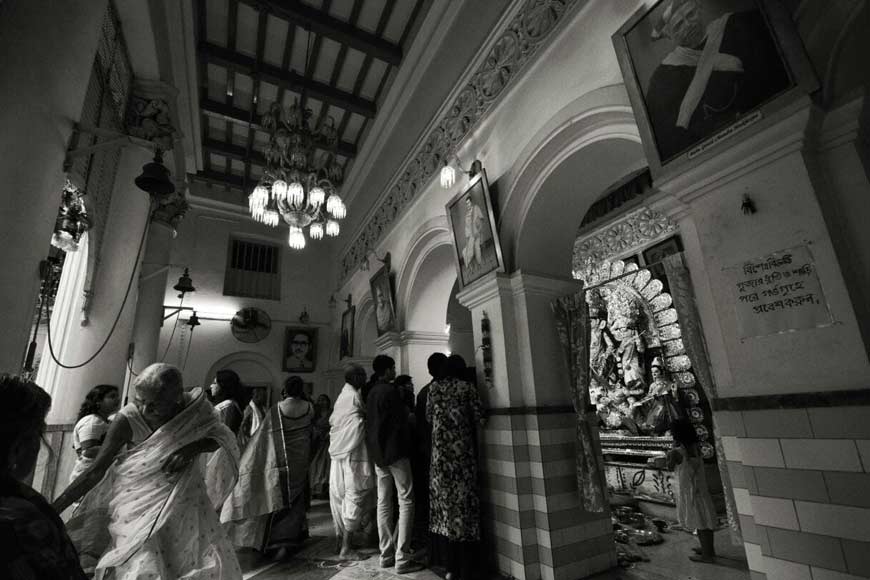
From time immemorial, the religious importance of the Ganga River may exceed that of any other river in the world. It has been revered from the earliest times and is believed to be the personification of Goddess Ganga. Hindu belief holds that bathing in the river causes the forgiveness of transgressions and helps attain salvation. The Ganga basin is one of the most intensely inhabited regions on earth, home to hundreds of millions of people, with the result that the river’s water over much of its course is highly polluted. Scores of cities and towns dump untreated sewage into the river and its main tributaries, and dozens of manufacturing facilities contribute industrial waste. Also contributing to high pollution levels are agricultural runoff, the remnants of partially burned or unburned bodies from funeral pyres, and animal carcasses. High levels of disease-causing bacteria, as well as toxic substances as chromium, cadmium, and arsenic, have been found in the Ganga. A large number of green activists like Somendra Mohan Ghosh have been working tirelessly for decades to sensitize people and urge the government to take steps to curb the rising pollution level.
The immersion process will be carried in the courtyard itself. Water-jet melting of the idols will be carried out with the help of hose pipes. After completion of the melting process, the clay will be collected and used the following year for sculpting the idols again. This process will not only help curb pollution but will also be financially viable, insists Ghosh.
Ghosh has been campaigning for a long time and appealing to puja organizers, especially to the members of the ‘Bonedi Baris’ (traditional household pujas by aristocratic families) to initiate measures to modify the immersion process and check river pollution. This crusader’s long and concentrated efforts have finally yielded results and from this year, the Mukherjee family of 39E, Girish Mukherjee Road, Bhowanipore, one of the renowned Bonedi families of Calcutta, has resolved to substitute the 190-year-old tradition and immerse the Durga idols on the ‘Thakur-dalan’ (open hall or courtyard where Puja is held) itself after Dashami (the 10th and final day of Durga Puja)! The Mukherjees are descendants of Girish Chandra Mukherjee, an eminent scholar and Munsif (Justice) in 19th century Calcutta, who promoted the Durga Puja at his residence initiated by his father in 1832.
The Mukherjees’ have been residing at their ancestral house for generations. Harachandra Mukherjee, father of Girish Chandra, hailed from Dhamua, a village in (South) 24 Parganas. He came to Calcutta and started his career as a priest. He also traded in jaggery and when his business began to flourish, he decided to settle down here. He bought a plot in Chakraberia area in Bhawanipore and constructed a thakur dalan adjacent to the residential house and initiated Durga Puja in 1832.
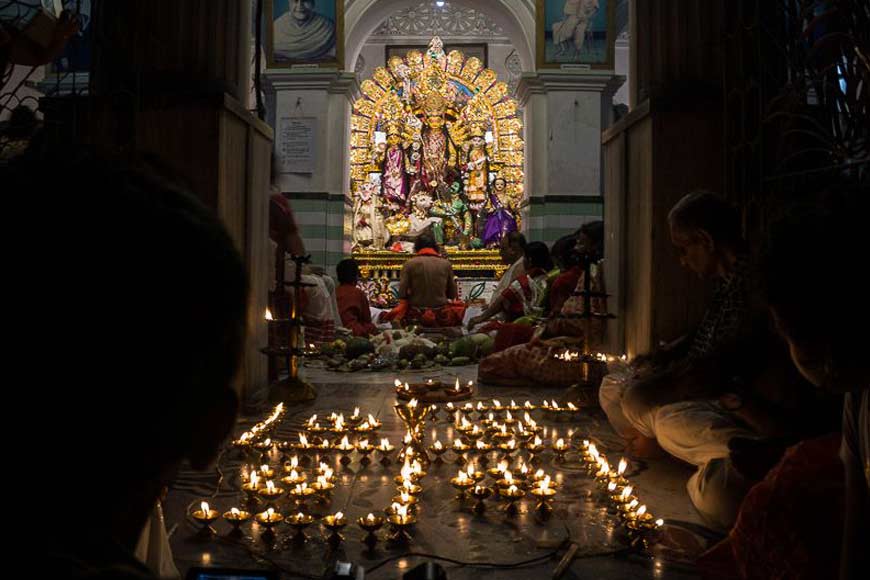
His son, Girish Chandra was a brilliant student and later, a faculty member of Sanskrit College. While working there, he impressed Vidyasagar with his sharp intellect and logical reasoning. Vidyasagar immediately took the youth under his wings and taught him English. It was Vidyasagar who urged Girish Chandra to study law and join the legal profession.
Girish Chandra received a monthly stipend of seven paise from Vidyasagar. Mukherjee accumulated a corpus from his stipend money and constructed a concrete Pujor-Dalan. Previously, the thakur dalan was a thatched roof house of clay. Mukherjee began his legal career as Munsif and went on to become a prominent and esteemed lawyer in Calcutta. In fact, Iswar Chandra asked him to be the principal attesting witness when he executed his will.
Since 1832, the four-day puja at Girish Bhawan has been an annual event and now is an integral part of Kolkata’s legacy. Every year, the task of idol making on the wooden frame (kathamo) formally starts from the auspicious day of ‘Ulto Rath’ (popularly known as Bahuda Yatra, it is the return journey of the Puri Jagannath Rath Yatra chariots from the Gundicha Temple after eight days. This marks the end of the Jagannath Rath Yatra). The artisans (potua) and drummers (dhaki) hail from Dhamua and are descendants of the families who were engaged 190 years ago when Girish Chandra started the Puja. Every year, they troop in from Dhamua and become part of the Mukherjee family for the next couple of months.
One of the highlights of the Pujo is that the kathamo (wooden frame) that was used in 1832 has been in use for all these years. The idols are sculpted in the Thakur-dalan and interestingly, members of the family decorate the puja mandap and the idols as well. In the past the ‘Ek Chala Thakur' (showcasing Goddess Durga and her children against one common backdrop) would be decked in ‘Daaker saaj’ (it incorporated the use of silver in the decorations in the form of foils, plates, ornaments etc.) but later the family members decided to deck the idols themselves. Now the female deities are draped in Banarasi sarees and male idols are clothed in dhotis. Indrani and Rathindra Mukherjee are pro in this department and have been performing the task for more than four decades now. After immersion, the clothes are given away to needy people.
The ‘Ghot’ (Kalash/ pitcher is one of the most important parts of Puja ritual and used for making offerings or puja) is set on the fifth day (Panchami). Another unique fact associated with Durga Puja at Girish Bhawan is that since the inception of the Puja, the patriarchs of the family have ensured an equal partnership of their women folk and that is why the ‘Puja Sankalpa (a solemn vow) is always made in the name of one of the daughters-in-law of the house. This was a coup of sorts, a very bold decision taken in the early part of 19th century when the condition of Indian women was not encouraging. Several evil traditions such as the practice of Sati, the Purdah system, child marriage, female infanticide, bride price and polygamy were all in vogue. The reform initiated at the Girish Bhawan at that time was a straight deviation from the social norms of 19th century Bengal. This tradition continues to this day. The women also participate in the family ritual held on Ashtami (the eighth day) called ‘Dhuni porano.’
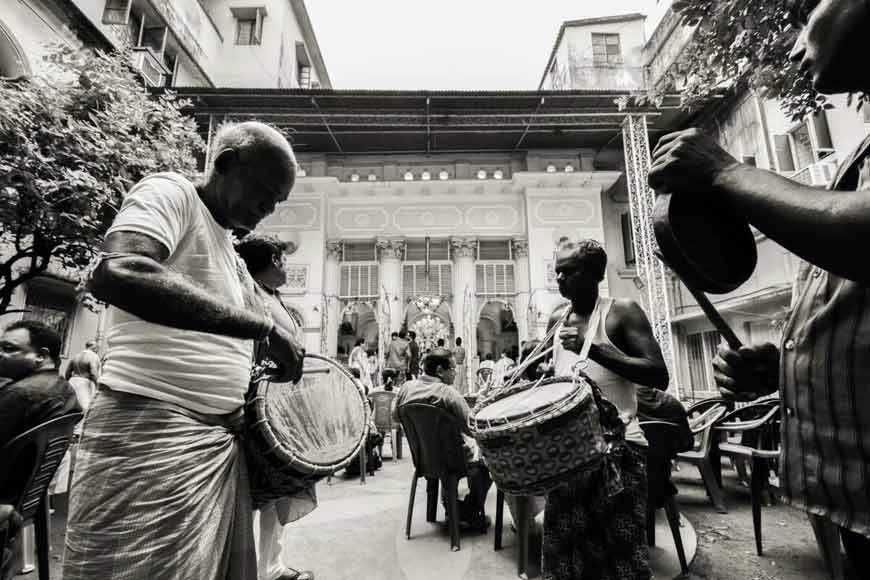
Another interesting ritual is followed on the final day of Puja. Bijoya Dashami marks the day when one bids adieu to Goddess Durga at the end of a five-day stay on Earth. In the morning, the male members of the family circumambulate the idol of Durga in a clockwise direction (pradakshina) chanting Durga ‘Stotra’ in unison. In the evening, the ladies perform ‘Debi Boron’ and indulge in Sindoor Khela after which the menfolk carry the idol on their shoulders like palanquin bearers and walk all the way to Adi Ganga for immersion.
Anirban Mukherjee, a member of the Mukherjee dynasty, says, "Although steeped in tradition, the Mukherjee family has always been broad-minded and open to changes for the greater benefit of society. In 2020, when the entire world was under the spate of COVID 19, for the first time in the history of the family’s Durga Puja, we unanimously decided to do away with idol worship and entertaining guests during the puja for fear of spreading the virus. We decided to curtail rituals and the goddess was ushered in and worshipped in the ‘Ghot.’ The same practice continued in 2021 as well and now, after a two-year interval, we are all looking forward to celebrate Durga Puja in a grand manner and open the gates to all our visitors this year."
Durga Puja at Girish Bhawan is performed in accordance with rituals introduced when the puja started 190 years ago, yet the family is open to suggestions and advices to alter rigid traditions and everyday practices (religious and otherwise) in favour of eco-friendly, sustainable policies for a greener and cleaner world. This year, the family has taken a bold decision to immerse the deities in a novel manner, something unheard of in Bengal so far. In Maharashtra, eco-friendly Ganesha idols were introduced during Ganesh Chaturthi a few years ago and they became quite a rage locally. These idols are made of clay, natural fibers, paper and other biodegradable materials and when they are immersed in water, they degrade faster and do not harm the environment as much as the ones made of plaster of paris (POP).
In a statement issued by the Girish Bhawan family makes it very clear: “Staying with the Vision for Ganga Rejuvenation Project ensuring “Aviral Dhara” (continuous flow), “Nirmal Dhara’ (unpolluted flow”), we have decided to contribute positively to this great initiative from this year (2022) on. We plan to follow our tradition of immersion through a new method of water jet melting via hose pipe in our courtyard. The remnants would be preserved and re-used next year, for building the idol
The state of Adi Ganga, the nearly 75 km long original channel of national river Ganga, is on its death throes. The river has been hijacked at several places. Three centuries back, this was the main outflow of the Ganga to the Bay of Bengal. Today it is a sewer buried under garbage and the Metro rail network, encroached upon, converted into personal ponds and homes. Immersion of idols have added to the river’s woes and there has been an alarming degradation in the quality of the river water itself. Incidentally, all Bonedi Bari families of South Kolkata follow the age-old ritual where the male members carry the idols on their shoulders and walk the entire stretch from their thakur dalan to Adi Ganga for immersion.
Eco activist Ghosh has been working steadfastly to inspire the ‘Bonedi Bari’ family members to think of alternative ways of immersion to stall choking the river further. The scheme itself was in choppy waters when he tried to moot the idea intially. A majority of senior members of the families staunchly believe that Ganga cannot be polluted. She is herself ‘Patita-pavan’ (one that cleanses the wretched and fallen) and it is sacrilegious to even doubt her purity. Ghosh then involved the younger generation and motivated them to incorporate the changes without hurting the sentiments of the older members of the family.
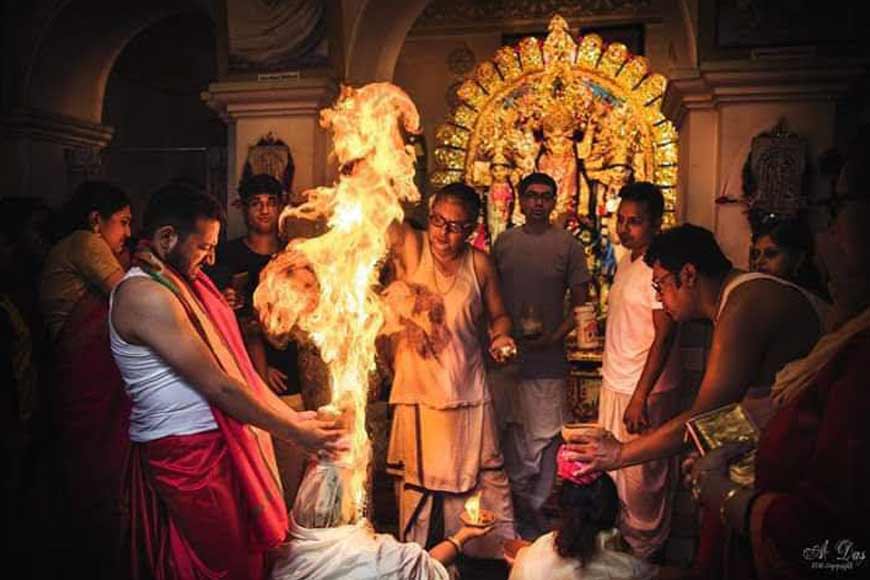
The Mukherjee family of Girish Bhawan has finally got over the mental block and come forward to take the lead. The family has vowed to introduce new-age immersion technique from this year to reduce water pollution. This is going to be the first ever eco-friendly immersion of Durga in India. Following Ghosh’s 3-R suggestion (reduce, reuse, recycle) of reducing pollution, recycling the materials like the soil and reusing the metal structure. Thus, the age-old wooden frame has been replaced this year by an aluminum structure that will be used annually. The structure has been engineered in such a manner that the idols will be hooked in the frame and it will be very convenient to detach each idol from the frame for immersion. The immersion process will be carried in the courtyard itself. Water-jet melting of the idols will be carried out with the help of hose pipes. After completion of the melting process, the clay will be collected and used the following year for sculpting the idols again. This process will not only help curb pollution but will also be financially viable, insists Ghosh.
This cost-effective green technology concept appealed to the younger generation. But the trickiest part was convincing the elderly member of the family. Ghosh then had a very strong argument in favour of the new concept. He said, since according to Hindu tradition, the ritual of ‘Darpan visarjan’ marks the end of immersion symbolically, on the morning of Vijaya Dashami, he suggested to use a pitcher full of holy Ganga water and pour it on the Darpan and that would complete the ritual and satisfy the veteran members. Ghosh is a happy man today as his decade-long campaign has finally yielded result and he says, “It's a bold step indeed to combine science and religion for reducing the toxic load in the holy river Ganga." He is hopeful that in the near future, other ‘Bonedi’ families will follow in the footsteps of Girish Bhawan.
In a statement issued by the Girish Bhawan family makes it very clear: “Staying with the Vision for Ganga Rejuvenation Project ensuring “Aviral Dhara” (continuous flow), “Nirmal Dhara’ (unpolluted flow”), we have decided to contribute positively to this great initiative from this year (2022) on. We plan to follow our tradition of immersion through a new method of water jet melting via hose pipe in our courtyard. The remnants would be preserved and re-used next year, for building the idol. While religious practices could be an age-old sentiment, as the generation of the tomorrow, we are committed to contribute to re-using and re-cycling of available natural resources.”
Meanwhile, Ghosh’s mission is not over yet. On Sunday, on the auspicious day of Mahalaya, Ghosh and other activists of ‘Sobuj Mancha’ have congregated and demonstrated in front of Bastuhara Bazar at 10.30 am and appeal to save Adi Ganga. However, he has been working on this issue for the past two decades and personally feels it is now too late to revive the river. “There seems little hope that the garbage and encroachments that have killed the Adi Ganga will be tackled in any meaningful way. However, dirty, pungent stagnant water in the Adi Ganga at Kalighat, Banshdroni areas has become a serious health hazard and we want the government to take initiative to dredge and clean the waterbody” says Ghosh.











